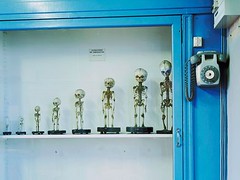The art gallery White Cube in London has just opened an exhibition of new works by Damien Hirst, called “Beyond Belief“:
In this exhibition, Hirst continues to explore the fundamental themes of human existence – life, death, truth, love, immortality and art itself. In two new series of paintings – the Fact Paintings and the Biopsy Paintings – Hirst confronts, as he puts it, ‘the intense joy and deep-set anxiety we can all feel in hospitals, where we are surrounded by both creation and decay’.
In the Biopsy Paintings, Hirst uses broken glass, scalpel blades and blood-like paint to create pictures based on microscopic images of different forms of cancer and other terminal illnesses. Like this one:

(Damien Hirst: “Appendix cancer light micrograph”).
More on the exhbition website. Show closes on 7 July. Must see it when I’m in London the last week of June. But I will probably be terribly disappointed …
(thanks to Martha for spreading the news)


